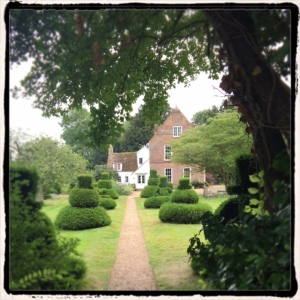
The Manor, Hemingford Grey
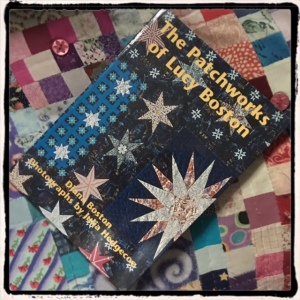
I knew that Lucy Boston (1892-1990) was the author of the children’s Green Knowe series and I remember reading The Castle of Yew years ago. But discovering that she was a stitcher meant that I looked at her work with new interest. The names of her quilts intrigued me: The Babes in the Wood Patchwork, The Patchwork of the Crosses and – most exciting of all – The High Magic Patchwork. These names give the quilts additional depth, for the naming of quilts is an important way of conveying the intention of the maker. Lucy Boston may have described the occupation of patchwork as “disorderly and messy, the room littered with snippets of paper, cotton and lengths of thread, and a maelstrom of materials,” but from disorder and mess comes beauty and deliberation.
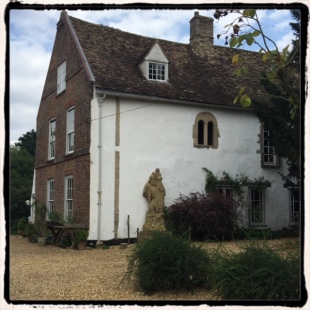
Tolly “saw the head of a giant stone man, carrying a child on his shoulders.”
I don’t actually remember reading the Green Knowe books as a child, but I must have done because, when I went into the room at the top of the house, “a room under the roof, with a ceiling the shape of the roof, with a ceiling the shape of the roof and all the beams showing,” there was Toby’s Japanese mouse and I knew him straight away.

“On the chest of drawers Tolly had seen two curly white china dogs, an old clock, and an ebony mouse, life-sized with shiny black eyes. It was so cleverly carved that you could see every hair, and it felt like fur to stroke.”
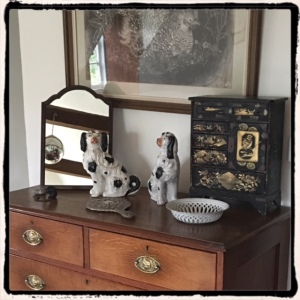
And there was more – “a beautiful old rocking-horse … a horse whose legs were stretched to full gallop, fixed to long rockers so that it could, if you rode it violently, both rear and kick.” The creak-croak of the rockers was almost audible. It was The Children of Green Knowe come to life – perfectly.
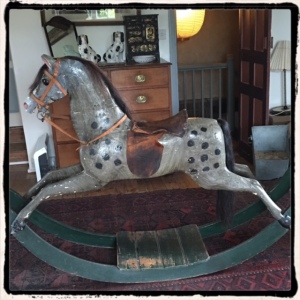
As well as the joy of finding Tolly’s room, I had the pleasure of seeing Lucy Boston’s quilts. I was especially privileged to be able to touch them, as, wearing white gloves, I helped our guide, Diana Boston, turn them out for viewing. The quilts are made from an eclectic range of fabrics – from wartime dusters to silk, from needlecord to embroidered wedding dress cotton, from heavy furnishing fabric to Liberty prints. Many pieces were fussy cut – with the sort of precision that I admire but never have the patience to achieve – and the piecing is extraordinary. There is a stunning Mariner’s Compass quilt – with twelve of that most complicated of blocks (which I have never dared attempt). When making it, Lucy Boston experienced a feeling known to all quilters: “My patchwork is proving very difficult indeed. It has large circular patterns that will not lie flat. They all heave up like rising tea-cakes.” The Babes in the Wood was a triumph of applique, as owls, birds and squirrels wandered amongst leaves and flowers in autumn colours. My favourite was the High Magic Patchwork: a mass of stars, suns and the phases of the moon. Lucy Boston made this piece when she was writing An Enemy at Green Knowe and noted that it “served to keep my thoughts moving.”
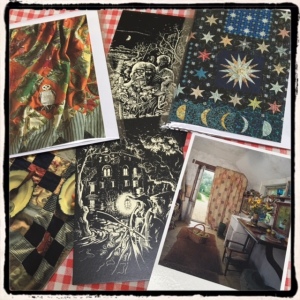
The Manor is open all year round and can be visited by appointment. The photography policy is very generous and visitors can take pictures all over the house and gardens. However, it isn’t possible to photograph the quilts. Instead, Diana Boston’s lovely book The Patchworks of Lucy Boston can be purchased from the Manor along with cards featuring some of the quilts (and proceeds go towards the upkeep of the house and garden). And the Patchwork of the Crosses, probably the most well-known of Lucy Boston’s quilts, can be seen here thanks to the British Quilt Study Group of the Quilters’ Guild of the British Isles.
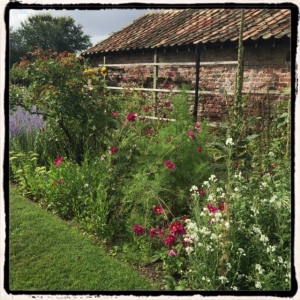
Terrific report of your visit and those quilts, *swoon*, very beautiful. I love how you fit sewing into history and culture
Well I had such wonderful company. Thank you for a splendid day out!
i love the way you write and this is so good ! i hope that one day you will consider writing a whole book like this , less a how to and more about the women who made the quilts and the whys. from what you say about Mrs Boston it is obvious that she felt a compulsion to patch and piece, like many of us now she’d been bitten by the bug and simply had to do it even if it meant doing it with dusters !
thanks for that . susan
just to add , have you read “old swedish quilts” by asa wettre? it’s one of my favourite quilt books and the kind i could see you making about uk quilting ! i even try to copy the old quilts in it from her photos and descriptions i like them so much. she has published a second book but no one seems to be translating it from the swedish x
Hello Susan. Thank you for your lovely comment. I don’t know the Asa Wettre book but it sounds fascinating. I must look out for it. I think – where we have them – the stories of makers and their motivations are really important in taking women’s work seriously.
I went to the Manor at the beginning of June, and had a wonderful time! I got to turn the quilts too. Since I’m a quilting librarian, and grew up on the Green Knowe books, it was an amazing experience for me (and my other family members too!).
Lovely to read a blog focussing on the quilts. I have just blogged about my own visit which was very much inspired by the books. Wonderful, magical place.
Makes me want to reread and visit as soon as I can!